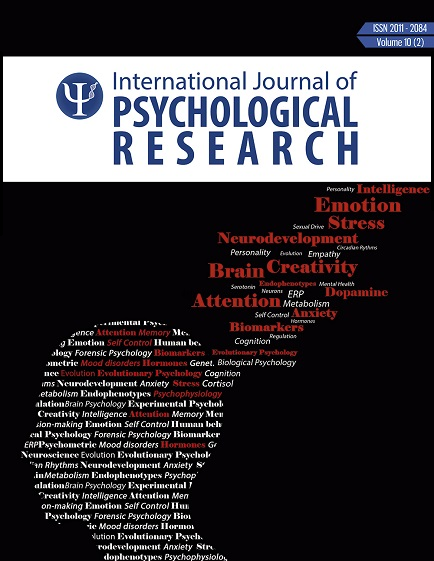To give up copyright, the authors allow that, International Journal of Psychological Research, distribute the work more broadly, check for the reuse by others and take care of the necessary procedures for the registration and administration of copyright; at the same time, our editorial board represents the interests of the author and allows authors to re-use his work in various forms. In response to the above, authors transfer copyright to the journal, International Journal of Psychological Research. This transfer does not imply other rights which are not those of authorship (for example those that concern about patents). Likewise, preserves the authors rights to use the work integral or partially in lectures, books and courses, as well as make copies for educational purposes. Finally, the authors may use freely the tables and figures in its future work, wherever make explicit reference to the previous publication in International Journal of Psychological Research. The assignment of copyright includes both virtual rights and forms of the article to allow the editorial to disseminate the work in the manner which it deems appropriate.
The editorial board reserves the right of amendments deemed necessary in the application of the rules of publication.
Resumen
Happiness has been proposed as an alternative goal in welfare analyses. Several indices have been proposed for its measurement but studies about their metric properties and validity are insufficient. In this paper, the Happy Planet Index is analyzed in terms of its consequential validity as a global health inequality indicator from the invariant measurement perspective of the Rasch model. Model fit is analyzed with emphasis on differential item functioning when comparing between world regions, and its consequential validity by comparing conclusions about the magnitude and inequalities in countries’ happiness. Main findings show enough evidences for structural and construct validity, but not for the supposed underlying score distribution; not either for its generalizability because of sever differential functioning. Conclusions about the magnitude of geographical inequalities and happiest countries substantially differed between the original index and the Rasch measure.
Referencias
Bond, T. G., & Fox, C. M. (2001). Applying the Rasch Model: Fundamental Measurement in the Human Sciences. Erlbaum.
Crane, P. K., Gibbons, L. E., Jolley, L., & van Belle, G. (2006). Differential item functioning analysis with ordinal logistic regression techniques. DIFdetect and difwithpar. Medical Care, 44(11 Suppl 3), S115-S123.
Cummins, R. (2016). Happiness is the Right Metric to Measure Good Societal Functioning. Society, 53(3), 273-277.
Darma, M. (2013). On the economics of happiness: the influence of income and non-income factors on happiness. South African Journal of Economic and Management Sciences, (1), 39.
Engelhard, G. (2013). Invariant measurement: using Rasch models in the social, behavioral, and health sciences. New York: Routledge.
Environmental Systems Research Institute. (n. d.). ESRI Web page. Retrieved from: http://www.esri.com/
Gallup. (n. d.). Gallup World Poll Website. Retrieved from: http://www.gallup.com/services/170945/world-poll.aspx
Gandelman, N., & Porzecanski, R. (2013). Happiness Inequality: How Much Is Reasonable? Social Indicators Research, 110(1), 257-269.
Global Footprint Network. (n. d.). Global Footprint Network Website. Retrieved from: http://www.footprintnetwork.org/es/
Houweling, T. A., Kunst, A. E., Huisman, M., & Mackenbach, J. P. (2007). Using relative and absolute measures for monitoring health inequalities: experiences from cross-national analyses on maternal and child health. International Journal for Equity in Health, 6, 15.
Johns, H., & Ormerod, P. (2007). Happiness, economics and public policy. London: Institute of Economic Affairs. Retrieved from: http://www.iea.org.uk/sites/default/files/publications/files/upldbook416pdf.pdf
Kalmijn, W. M., & Arends, L. R. (2010). Measures of Inequality: Application to Happiness in Nations. Social Indicators Research, 99(1), 147-162.
Kalmijn, W., & Veenhoven, R. (2005). Measuring Inequality of Happiness in Nations: In Search for Proper Statistics. Journal of Happiness Studies, 6(4), 357-396.
Kalmijn, W., & Veenhoven, R. (2014). Index of Inequality-Adjusted Happiness (IAH) Improved: A Research Note. Journal of Happiness Studies, 15(6), 1259-1265.
King, N. B., Harper, S., & Young, M. E. (2012). Use of relative and absolute effect measures in reporting health inequalities: structured review. BMJ (Clinical research ed.), 345, e5774.
Larsen, K., & Merlo, J. (2005). Appropriate assessment of neighborhood effects on individual health: integrating random and fixed effects in multilevel logistic regression. American Journal of Epidemiology, 161(1), 81-88.
Merlo, J., Chaix, B., Yang, M., Lynch, J., & Rastam, L. (2005). A brief conceptual tutorial of multilevel analysis in social epidemiology: linking the statistical concept of clustering to the idea of contextual phenomenon. Journal of Epidemiology and Community Health, 59(6), 443-449.
Messick, S. (1995). Validity of psychological assessment: Validation of inferences from persons’ responses and performances as scientific inquiry into score meaning. American Psychologist, 50(9), 741-749.
Stewart, F. (2014). Against Happiness: A Critical Appraisal of the Use of Measures of Happiness for Evaluating Progress in Development. Journal of Human Development & Capabilities, 15(4), 293-307.
The New Economics Foundation. (n. d.-a). Happy Planet Index. Retrieved from: http://www.happyplanetindex.org/data/
The New Economics Foundation. (n. d.-b). The happy planet index: 2012 report. Retrieved from: http://www.happyplanetindex.org/assets/happy-planet-index-report.pdf
The Sustainable Development Solutions Network. (2016). World Happiness Report, 2016 volume I. Retrieved from: https://templatearchive.com/world-happiness-report/
UNDP (Ed.). (2011). Sustainability and equity: a better future for all. Houndmills: Palgrave Macmillan. Retrieved from: http://hdr.undp.org/sites/default/files/reports/271/hdr_2011_en_complete.pdf
Wilson, M. (2005). Constructing Measures: An Item Response Modeling Approach. Routledge.
Wolfe, E. W., & Smith, E. V., Jr. (2007). Instrument development tools and activities for measure validation using Rasch models: part II--validation activities. Journal of Applied Measurement, 8(2), 204-234.

































